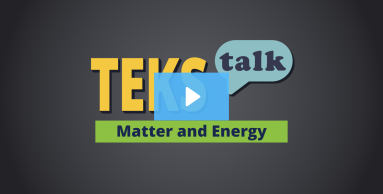- Science
- Grade 2
- Matter and its properties
Science.2.6.B
conduct a descriptive investigation to explain how physical properties can be changed through processes such as cutting, folding, sanding, melting, or freezing; and

Knowledge and Skills Statement
Students are expected to conduct a descriptive investigation, meaning they should be able to record changes to physical properties of a variety of substances. Provide students with a selection of tools they might use to investigate changing physical properties. Some examples include scissors, paper, sandpaper, wood blocks, a hair dryer, crayons, ice, water, and access to a freezer. Ask students to make a plan to change the physical properties of the objects provided. Student plans should indicate that they understand changing physical properties might mean changing the size, shape, or temperature of an object. Student observations should indicate which object they are examining and describe the process they used to change its physical properties. For example, a student might say, "I changed the size of the wood block by sanding it and making it smaller." Students should understand that changing the physical properties of an object does not change the type of object. They should be able to say "When I freeze water, it is still water, just not a liquid."
The further explanation is designed to be a resource for educators that helps them better understand the topic their students are learning. Further explanations may be written at a more complex level than would be expected for students at the grade level.
The emphasis in student expectation 2.6.B is on how the observable physical properties of a substance change through the processes listed. Often the processes of melting and freezing are associated with the change in state of matter from solid to liquid and from liquid to solid. Grade 2 students should focus their observations on the changes they can see. In grade 3, students will describe explain why those changes are occuring by describing particle behavior in solids, liquids, and gasses. In middle school, students will be introduced to the concept of atoms as the building blocks of matter.
One common misconception is that all physical changes are reversible changes. An example of a physical change that is irreversible is when a rock is broken into pieces.
Research
Bobrowsky, Matt. “Q: What Makes a Great Science Investigation?” Science and Children 59, no. 5 (2022): 62–65.
www.nsta.org/science-and-children/science-and-children-mayjune-2022/q-what-makes-great-science-investigation.
Summary: This article explains the importance of students conducting investigations and what steps teachers can take to help guide them. Students should start by exploring a new phenomenon with a hands-on activity to spark engagement and curiosity. These investigations help students gain scientific skills such as observing, collecting, and making predictions. This article lists open-ended questions teachers can ask that require deep thought from students. It is helpful for students to conduct investigations that help solve a problem. Students benefit from working in groups because they can discuss how to find a solution. Students should also consider what materials will work best to help their investigation. Students should test their product to see if it has solved the problem and make changes as needed.
